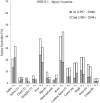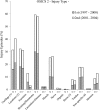Epidemiology of injuries in elite taekwondo athletes: two Olympic periods cross-sectional retrospective study
- PMID: 24531455
- PMCID: PMC3927815
- DOI: 10.1136/bmjopen-2013-004605
Epidemiology of injuries in elite taekwondo athletes: two Olympic periods cross-sectional retrospective study
Abstract
Objective: Taekwondo injuries differ according to the characteristics of the athletes and the competition. This analytical cross-sectional retrospective cohort study aimed to describe reported taekwondo injuries and to determine the prevalence, characteristics and possible risk factors for injuries sustained by athletes of the Spanish national team. In addition, we compared each identified risk factor-age, weight category, annual quarter, injury timing and competition difficulty level-with its relation to injury location and type.
Settings: Injury occurrences in taekwondo athletes of the Spanish national team during two Olympic periods at the High Performance Centre in Barcelona were analysed.
Participants: 48 taekwondo athletes (22 male, 26 female; age range 15-31 years) were studied; 1678 injury episodes occurred. Inclusion criteria were: (1) having trained with the national taekwondo group for a minimum of one sports season; (2) being a member of the Spanish national team.
Results: Independently of sex or Olympic period, the anatomical sites with most injury episodes were knee (21.3%), foot (17.0%), ankle (12.2%), thigh (11.4%) and lower leg (8.8%). Contusions (29.3%) and cartilage (17.6%) and joint (15.7%) injuries were the prevalent types of injury. Chronological age, weight category and annual quarter can be considered risk factors for sustaining injuries in male and female elite taekwondists according to their location and type (p≤0.001).
Conclusions: This study provides epidemiological information that will help to inform future injury surveillance studies and the development of prevention strategies and recommendations to reduce the number of injuries in taekwondo competition.
Keywords: Rehabilitation Medicine; Sports Medicine.
Figures


References
-
- World-Taekwondo-Federation. http://www.wtf.org/wtf_eng/main/main_eng.html (accessed 29 Apr 2013)
-
- Heller J, Peric T, Dlouha R, et al. Physiological profiles of male and female taekwondo (ITF) black belts. J Sports Sci 1998;16:243–9 - PubMed
-
- Gao B. Research on the somatotype features of chinese elite male taekwondo athletes. Sport Sci 2001;21:58–61
-
- Ball N, Nolan E, Wheeler K. Anthropometrical, physiological, and tracked power profiles of elite taekwondo athletes 9 weeks before the olympic competition phase. J Strength Cond Res 2011;25:2752–63 - PubMed
Publication types
MeSH terms
LinkOut - more resources
Full Text Sources
Other Literature Sources
